![]()
![]()
![]()
Use LEFT and RIGHT arrow keys to navigate between flashcards;
Use UP and DOWN arrow keys to flip the card;
H to show hint;
A reads text to speech;
52 Cards in this Set
- Front
- Back
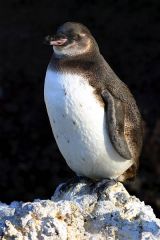
|
Sphenisciformes Penguins |
|
|
Sphenisciformes |
Southeren Hemisphere Upright Posture Flightless Divers |
|
|
Features that adapt Penguins to Diving
|
Flippers
Solid Bones No Apteria Specialized Hemoglobin Can reduce metabolism Can shut down non-essential organs Can Shunt blood away from extremities |
|
|
Breeding of Penguins (male and female roles)
|
3-4 months
Female: Goes and forages Males: Incubates single egg |
|
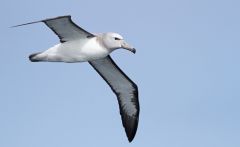
|
Procellariformes
(Albatrosses, Diving Petrels, Storm Petrels, Shearwaters) |
|
|
Procellariformes |
Tube nose=olfaction find burrow, food Hooked bill Characteristic odor (Squirt stomach oil at intruders) Cosmopolitan (Most South Hemisphere) Pelagic Most unable to walk on land Difficult to take off Land time=breeding (in colonies) Nest=burrows 1 egg |
|
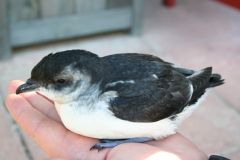
|
Diving Petrel
|
|

|
Shearwater
|
|
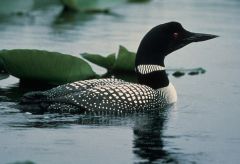
|
Gaviiformes Loons
|
|
|
Gaviiformes |
Diving bird features Piscivorous Long lived (20-28) Monogamous "sound" |
|
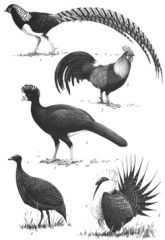
|
Galliformes Fowl
Moundbuilders, Guans, Curassows, Charchalacas, Guineafowl, New World Quails, Pheasants, Chickens Peacocks |
|
|
Galliformes |
Cosmopolitan Ground forage Large gizzards and intestinal ceacae Large clutches |
|
|
Galloanserae
|
Galliformes + Anseriformes
|
|

|
Mound builders Megapodiidae
|
|

|
Guans and Curassows Cracidae
|
|
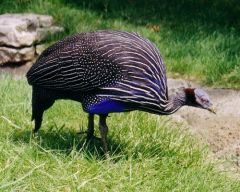
|
Guineafowl Numididae
|
|
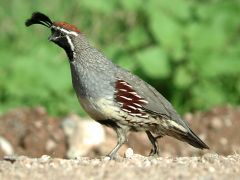
|
New World Quail Odontophoridae
|
|
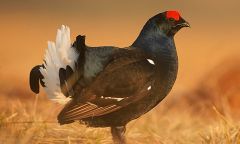
|
Phasianidae Pheasants, peacocks, turkeys
|
|
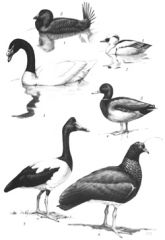
|
Anseriformes Waterfowl
Swans, Ducks, geese, screamers Anatidae (Swans, Ducks, Geese) Anseranatidae (Magpie Goose) Anhimidae (Screamers) |
|
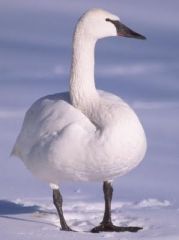
|
Ducks, Geese and Swans Anatidae
Feet: Webbed, flattened Most = herbivorous Have a penis Precocial young Care=females |
|
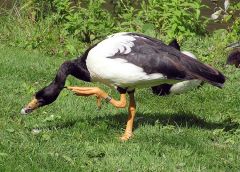
|
Magpie goose Anseranatidae
|
|
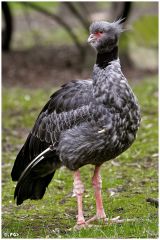
|
Screamer Anhimidae
No uncinate processes Partial web feel Spurs for fighting No feather tracts Chicken like bill Swamplands |
|
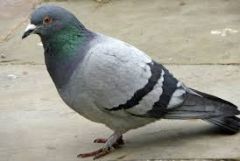
|
Columbiformes Pigeons and Doves |
|
|
Columbiformes |
well developed flight muscles small head, short bill and short legs Cosmopolitan distribution Almost all terrestrial (varied) habitats Lay two eggs Eat fruit or seeds Crop milk Muscular Gizzard fleshy cere at the base of the bill oil gland is small or absent, and the feathers have no aftershaft. Young naked Can suck up water |
|
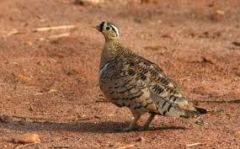
|
Pteroclidiformes Sandgrouse |
|
|
Pteroclidiformes |
superficially similar to partridges or pigeons short bill, small head, long wings, short legs feathered tarsi; toes sometimes feathered. Large crop open areas, generally in arid or semi-arid zones. Dry Seeds carry water in soaked breast feathers - for babies Nest on ground young have down Can't suck up water |
|

|
Mesitornithiformes Mesites |
|
|
Mesitornithiformes |
Medium-sized terrestrial birds long, full tail, short wings and stout legs Nearly flightless Forest, woodland and thicket |
|
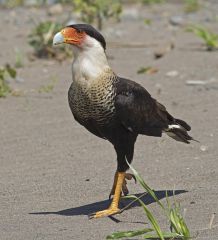
|
Falconiformes Falcons and Caracaras |
|
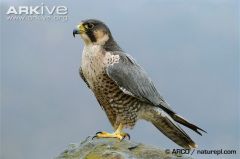
|
Falcon |
|
|
Falconiformes |
Falcons: worldwide Caracaras: C and S America Tomial Tooth (Ancestor, Terror Birds) |
|
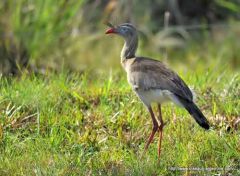
|
Cariamiformes Seriemas |
|
|
Cariamiformes |
Large long-legged terrestrial birds hawk-like head and long neck and tail Grassland, savanna, dry woodland and open forests. |
|
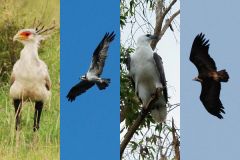
|
Accipritriformes Hawks, Eagles, OW Vultures, Secretarybird, Ospreys, NW World Vultures |
|
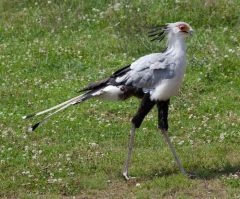
|
Secretary Bird |
|
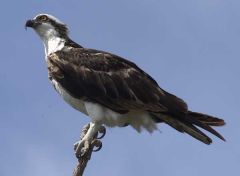
|
Osprey |
|
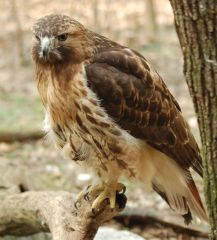
|
Hawk |
|
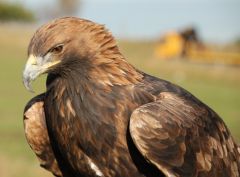
|
Eagle |
|
|
Osprey Feet |
Toes - equal length Tarsi - reticulate Talons - rounded Outer toe reversible (grasp with two in front and two behind) Underside of foot - sharp spicules |
|
|
Secretary Bird Prey Catching |
Use long legs and feet to catch vertebrates while on the ground |
|

|
Phoenicopteriformes Flamingos |
|
|
Phoenicopteriformes |
Males Larger large, shallow (oftenbrackish) lagoons, often athigh altitudes Wander nomadically,Breed erratically in dense, synchronized colonies algae and tiny crustaceans raised mud nest, single Chick; fed “crop milk” grebes are the closest living relatives |
|
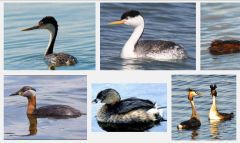
|
Podicipediformes Grebes |
|
|
Podicipediformes |
Diving birds (foot propelled, lobed feet, laterally compressed tarsi) difficulty getting airborne Eat own feathers (to trap fish bones?) Tails reduced Nest usually a floating platform young carried on back |
|
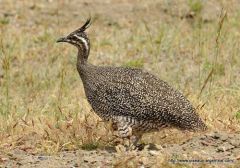
|
Tinamiformes Tinamous |
|
|
Tinamiformes |
New World tropics Very old 10 mya Fowl-like live on forest floor Limited flight ability lack keeled sternum |
|
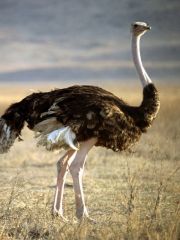
|
Struthioniformes Ostriches |
|
|
Paleognathes |
"Ratites" and Tinamous 5 different orders including Tinamiformes and Struthioniformes |
|
|
"Ratites" (excluding kiwis) Cassowary (New Guinea) Rhea (S America) Emu (Australia) Ostrich (Africa) |
Primitive palate No keeled sternum No furcula Unvaned feathers No preening or oil glands Feathers not in patches Loss of flight is secondary |
|
|
Kiwis (Dinornithiformes) |
chicken size, hairlike feathers nostrils and highly developed sensory aperatus on the end of the snout, nocturnal “wormivores” |
|
|
Moas |
Extinct
From New Zealand |
|
|
Elephant Bird |
Extinct endemic to Madagascar largest bird known to science |

